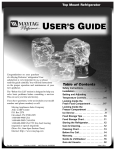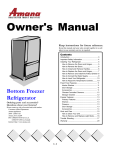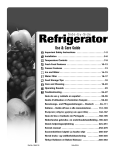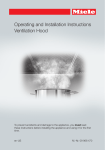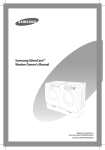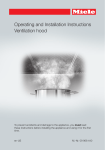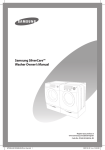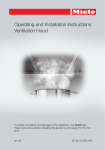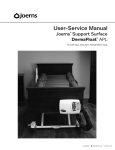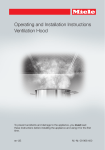Download Maytag G32026PExx User's Manual
Transcript
Bottom Freezer Use & Care Guide Important Safety Instructions . . . . . . . . 1-2 Guía de uso y cuidado en español . . . . . . . . . . . . . . . . . 22-43 Installation . . . . . . . . . . . . . . . . . . . . . . . 3-7 Guide d’utilisation et d’entretien français . . . . . . . . . . . 44-65 Temperature Controls . . . . . . . . . . . . . . . . 8 Benutzungs- und Pflegeanleitungen – Deutsch . . . . . . 66-87 Fresh Food Features . . . . . . . . . . . . . . . 9-11 Italiano – Guida all’uso e alla manutenzione . . . . . . . . 88-109 Freezer Features . . . . . . . . . . . . . . . . . . . . 12 ∂ÏÏËÓÈΤ˜ Ô‰ËÁ›Â˜ ¯Ú‹Û˘ Î·È ÊÚÔÓÙ›‰·˜ . . . . . . . . . 110-131 Food Storage Tips . . . . . . . . . . . . . . . . . . 13 Guia de Uso e Cuidado em Português . . . . . . . . . . . . .132-153 Care and Cleaning . . . . . . . . . . . . . . . 14-17 Nederlandse gebruiks- en onderhoudshandleiding . .154-175 Operating Sounds . . . . . . . . . . . . . . . . . . 18 Dansk betjeningsvejledning . . . . . . . . . . . . . . . . . . . . . 176-197 Troubleshooting . . . . . . . . . . . . . . . . . 19-21 Svensk manual . . . . . . . . . . . . . . . . . . . . . . . . . . . . . . . .198-219 Suomenkielinen käyttö- ja huolto-ohje . . . . . . . . . . . 220-241 Norsk bruks- og vedlikeholdsanvisning . . . . . . . . . . 242-263 Türkçe Kullanım ve Bakım Kılavuzu . . . . . . . . . . . . . . .264-287 Part No. 12828113 Litho U.S.A. Important Safety Instructions Installer: Please leave this guide with this appliance. Consumer: Please read and keep this Use & Care Guide for future reference. This guide provides proper use and maintenance information. Keep sales receipt and/or cancelled check as proof of purchase. Have complete model and serial number identification of your refrigerator. This is located on a data plate inside the refrigerator compartment, on the upper left side. Record these numbers below for easy access. Model Number _______________________________ Serial Number ________________________________ Recognize Safety Symbols, Words, Labels DANGER DANGER – Immediate hazards which WILL result in severe personal injury or death. WARNING WARNING – Hazards or unsafe practices which COULD result in severe personal injury or death. CAUTION CAUTION – Hazards or unsafe practices which COULD result in minor personal injury or property damage. DANGER Date of Purchase ______________________________ In our continuing effort to improve the quality and performance of our appliances, it may be necessary to make changes to the appliance without revising this guide. What You Need to Know About Safety Instructions Warning and Important Safety Instructions appearing in this guide are not meant to cover all possible conditions and situations that may occur. Common sense, caution and care must be exercised when installing, maintaining or operating appliance. Always contact the manufacturer about problems or conditions you do not understand. 1 To reduce risk of injury or death, follow basic precautions, including the following: IMPORTANT: Junked or abandoned refrigerators are still dangerous – even if they sit out for “just a few days.” If you are getting rid of your old refrigerator, please follow the instructions below to help prevent accidents. Before you throw away your old refrigerator or freezer: • Take off the doors. • Leave the shelves in place so children may not easily climb inside. Important Safety Instructions WARNING To reduce risk of fire, electric shock, serious injury or death when using your refrigerator, follow these basic precautions, including the following: 1. Read all instructions before using the refrigerator. 2. Observe all local codes and ordinances. 3. Be sure to follow earthing instructions. 4. Check with a qualified electrician if you are not sure this appliance is properly earthed. 5. Do not earth to a gas line. 6. Do not earth to a cold-water pipe. 7. Refrigerator is designed to operate on a separate 220-240 volt, 10 amp., 50 HZ cycle line. 8. Do not modify plug on power cord. If plug does not fit electrical outlet, have proper outlet installed by a qualified electrician. 9. Do not use a two-prong adapter, extension cord or power strip. 10. Do not tamper with refrigerator controls. 11. Do not service or replace any part of refrigerator unless specifically recommended in Use & Care Guide or published user-repair instructions. Do not attempt service if instructions are not understood or if they are beyond personal skill level. 13. Install refrigerator according to Installation Instructions. All connections for water, electrical power and earthing must comply with local codes and be made by licensed personnel when required. 14. Keep your refrigerator in good condition. Bumping or dropping refrigerator can damage refrigerator or cause refrigerator to malfunction or leak. If damage occurs, have refrigerator checked by qualified service technician. 15. Replace worn power cords and/or loose plugs. 16. Always read and follow manufacturer’s storage and ideal environment instructions for items being stored in refrigerator. 17. Your refrigerator should not be operated in the presence of explosive fumes. 18. Children should not climb, hang or stand on any part of the refrigerator. 19. Clean up spills or water leakage associated with water installation. 20. The appliance is not intended for use by young children or infirm persons without supervision. 21. Young children should be supervised to ensure that they do not play with the appliance. 12. Always disconnect refrigerator from electrical supply before attempting any service. Disconnect power cord by grasping the plug, not the cord. Installing Your Refrigerator These instructions were provided to aid you in the installation of your unit. The manufacturer cannot be responsible for improper installation. Steps to Follow... A qualified engineer must connect refrigerator in accordance with these installation instructions. Measure door opening and depth and width of refrigerator. Remove handles or doors if required. Engineer must also do the following: 1. Follow local water and electrical company connection regulations. 2. Complete water supply connection before electrical supply connections. Service to or replacement of power cord must be performed by a qualified engineer. Note When writing or calling about a service problem, please include the following information: a. Your name, address and telephone number; d. A clear description of the problem you are having; b. Model number and serial number; e. Proof of purchase (sales receipt) c. Name and address of your dealer or engineer; SAVE THESE INSTRUCTIONS FOR FUTURE REFERENCE 2 Installation WARNING To be done by a qualified engineer only. Your refrigerator was packed carefully for shipment. Remove and discard shelf packaging and tape. Do not remove the serial plate. Measuring the Opening When installing your refrigerator, measure carefully. One-half inch (1.3 cm) of air space should be provided for the top and back of the refrigerator. Note: 60 cm deep models Trim corners of countertop to a 45° angle if countertop has 25 mm overhang. Provide 5 mm clearance on both sides of refrigerator, and allow 7 mm on top for ease of installation and leveling. No minimum clearance is required at the rear of the cabinet. Subflooring or floor coverings (i.e. carpet, tile, wood floors, rugs) may make your opening smaller than anticipated. Some clearance may be gained by using the leveling procedure under Leveling. IMPORTANT: If refrigerator is to be installed into a recess where the top of the refrigerator is completely covered, use dimensions from floor to top of hinge cap to verify proper clearance. Transporting Your Refrigerator • NEVER transport refrigerator on its side. If an upright position is not possible, lay refrigerator on its back. Allow refrigerator to sit upright for approximately 30 minutes before plugging it in to assure oil returns to the compressor. Plugging the refrigerator in immediately may cause damage to internal parts. • Use an appliance dolly when moving refrigerator. ALWAYS truck refrigerator from its side or back–NEVER from its front. • Protect outside finish of refrigerator during transport by wrapping cabinet in blankets or inserting padding between the refrigerator and dolly. 3 • Secure refrigerator to dolly firmly with straps or bungee cords. Thread straps through handles when possible. Do not overtighten. Overtightening restraints may dent or damage outside finish. Location • Do not install refrigerator near oven, radiator or other heat source. If not possible, shield refrigerator with cabinet material. • Do not install where temperature falls below 13° C or rises above 95° C. Malfunction may occur at this temperature. • Refrigerator is designed for indoor household application only. How to Remove and Replace Door and Hinges WARNING Contact a qualified engineer to perform this task. How to Connect the Water Supply (select models) WARNING Contact a qualified engineer to perform this task. Leveling CAUTION To protect property and refrigerator from damage, observe the following: • Protect vinyl or other flooring with cardboard, rugs, or other protective material. • Do not use power tools when performing leveling procedure. To enhance the appearance and maintain performance, the refrigerator should be level. (side to side) Note • Complete any required door reversal, panel installation and/or a water supply connection, before leveling. Materials Needed • 3⁄8" hex head driver • Carpenter’s level 1. Remove toe grille. • Grasp firmly and pull outward to unclip. Installation 2. Remove bottom bracket cover(s). Note • Place the eraser end of a pencil or similar blunt tool in the cover notch. • For proper reinstallation, ensure the “top” marking on the interior of the toe grille is oriented correctly. • Align the toe grille mounting clips with the lower cabinet slots. Notch Location • Snap bottom portion into place first. Press down on top of grille until top portion snaps into place. • Use slight pressure to pry the cover loose. For pullout drawer only: • Continue to maintain downward pressure to the notched side of the cover while swinging it off. 3. Using hex head driver, turn the front adjustment screws (A) on each side to raise or lower the front of the refrigerator. A B 1. Turn both stabilizing legs clockwise until Stabilizing firmly against floor. Leg Turn roller adjustment screws 2 to 3 times counterclockwise so that the full weight of refrigerator rests on stabilizing legs. 2. Replace toe grille and bracket cover(s). See markings on inside of toe grille to insure proper placement. BA C Roller Adjustment Screw C Note • Some models only have adjustment screws “A.” Handles If not installed, the handle is located in the interior of the fresh food section or attached to the back of your refrigerator. Remove and discard handle packaging and tape. 4. Select models also have rear adjustment screws (B). Using the hex head driver, turn each of these adjustment screws (B) to raise or lower the rear of the refrigerator. 5. Using the carpenter’s level, make sure front of refrigerator is 6 mm or half bubble higher than back of refrigerator and that the refrigerator is level from side to side. Handle design varies from refrigerator to refrigerator. Please reference the appropriate instructions for your model below. Fresh Food Handles Front Mount Handle - Style 1 Materials Needed 6. Turn stabilizing legs (C) clockwise until firmly against floor. • Phillips screwdriver • 5⁄16" hex head driver 7. Freezer drawer models only: Turn adjustment screws (A) counterclockwise to allow the full weight of the refrigerator to rest on the stabilizing legs. To Install: 8. Replace bracket cover(s). • Position cover into the outer edge of the hinge. • Swing the cover toward the cabinet and snap it into place. 9. Replace the toe grille. 1. Remove 0.6 cm hex head screws from door face with hex head driver, and Phillips screw from top of door. • If reversing door, remove door plugs from opposite side of door and insert in screw holes. 2. Align handle holes with screw holes on door face and secure with two door face screws from step 1. 4 Installation 3. Locate handle trim in literature pack and install over top and bottom of handle, as illustrated. • Secure top handle trim with remaining screw removed in step 1. • Snap bottom trim over bottom portion of handle. To Remove: 1. Remove top handle trim by removing top handle screw. • Retain trim and screw for later replacement. 2. Pry bottom handle trim from handle with screwdriver flat blade wrapped in masking tape. • Retain trim for later replacement. 3. Remove two hex head screws. • Retain screws for later replacement. Side Mount Handle Materials Needed To Install: 1. Remove screws from the side of the door. 2. Align the side mount handle with the predrilled holes in the door panel. 3. Insert the screws in the sequence as shown. Upper Handle 3 Partial-Width Handle Materials Needed • Phillips screwdriver To Install: 1. Install handle by fastening with screws removed from edge of door. • If reversing freezer door, remove door plugs from top edge of door and insert into screw holes. To Remove: 1. Remove handle screws with Phillips screwdriver and retain screws for later use. Front Mount Handle - style 2 Materials Needed • Gloves to protect hands • Phillips screwdriver • Plastic door removal card (or 0.1 cm thick plastic card), retain the card Attach Extensions to Handle: (select models) • Phillips screwdriver 1 Freezer Handles 2 4 Lower Handle 4. Ensure the door handle is snug to the door panel. To Remove: Reverse installation procedure. 1. Align handle and extension as shown. 2. Place extension in handle opening. 3. Apply slight pressure to both sides of the extension piece. 4. Slide extension until it stops on inside edge of handle. To Install: 1. The handles are to be oriented as shown. 2. Align front mount door handle clip with the door tabs. 3. Ensure the handle clips are positioned slightly above the door tabs. Handle Clip Door Tab 5 Installation 4. Rotate the handle so that the handle is flat against the door. Front Mount Freezer Handle Materials Needed • Gloves to protect hands. • Phillips screwdriver. • Plastic handle removal card (or 0.1 cm thick plastic card). Retain the card. 5. Push the handle down against the upper door tab just enough to allow it to hang unsupported. Notes • There is a slight curve to this style of freezer handle. • For proper installation, be sure handle is oriented as shown. 6. Align bottom of handle with lower door tab. Press upper handle end to door surface and firmly grasp lower end of handle. Gently slide handle upward until bottom of handle settles on door surface, then reverse direction, sliding downward to almost engaging tab with clip. 7. Grasp the handle firmly and slide down until it clicks. The audible click indicates fastening clips are securely interlocked. To Install: 1. Align door handle clips slightly to the left of the tabs attached to the freezer door. 2. Rotate the handle so the left base is flat against the door. Handle Clip Door Tab Handle Base To Remove: 1. Flex the handle away from the door panel. Simultaneously place door handle removal card underneath the base of the lower handle. Insert the card to the line or until it stops. 2. Grasp the lower part of the handle firmly and lift to remove. 3. Push the left handle base against the left door tab and slightly to the right, just enough to allow it to hang unsupported. 4. While firmly supporting the left handle base against the door, align the right base of the handle with the right tabs that are attached to the door. 5. Now, while firmly holding the handle at the left and right bases, gently slide the handle towards the right until the right base settles in. The handle should now be flat against the face of the freezer door at both the left and right bases. 6. With hands still firmly keeping the handle flat against the freezer door, you may have to reverse directions momentarily to assure clip/tab engagement. Then firmly slide the handle to the right until it clicks. The audible "click" indicates that the fastening clips are securely interlocked. 6 Installation To Remove: 1. At the right end, flex the handle base away from the surface of the freezer drawer. Simultaneously slide the door handle removal card that came with your refrigerator under the right side base of the handle. Slide the card to the line indication or until it stops. 2. With both hands, firmly grasp the handle towards the right base. 3. Slide towards the left, lift and remove from the surface. When the left door is opened, the hinged seal automatically folds inward so that it is out of the way. WARNING To avoid electrical shock which can cause severe personal injury or death, DO NOT attempt to remove the hinged seal from the fresh food section. CAUTION To avoid possible product damage, ALWAYS verify that the hinged seal is folded against the edge of the door prior to closing. Hinged Seal Handle Removal Euro Handles This handle style is installed at the factory Materials Needed: • 3⁄32” allen wrench To Remove: • Remove set screw from handle mounting post using 3 ⁄32” allen wrench. • Repeat the procedure on all posts to remove the handle. To Replace: • Align handle with the mounting posts. • Fully tighten all set screws to secure handle in place. Opening and Closing Your Fresh Food Doors (select models) How to Connect the Water Supply (select models) WARNING Contact a qualified engineer to perform this task. Ice Maker Operation • To turn ice maker On push arm down from locked position. Your new refrigerator is uniquely designed with two fresh food doors. Either door can be opened or closed independently of one another. 7 There is a vertically-hinged section on the left fresh food door. When the left door is closed, the hinged section automatically forms a seal between the two doors when both doors are closed. • Lift arm up and lock into position to turn ice maker Off. Temperature Controls Touch Temperature Controls Adjusting the Controls (select models, style varies by model) • 24 hours after adding food, you may decide that one or both compartments should be colder or warmer. If so, adjust the control(s) as indicated in the Temperature Control Guide table below. See page 13 for instructions on checking compartment temperature. The controls are located at the top front of the refrigerator compartment. Control • Except when starting the refrigerator, do not change either control more than one number at a time. Initial Control Settings After plugging the refrigerator in, set the controls. • Pressing the or to the desired setting. pads adjusts the controls • The temperature control range for both compartments is 1 through 7 (coldest). • Allow 24 hours for temperatures to stabilize. Temperature Control Guide Refrigerator too warm Set the refrigerator control to next higher number by pressing the pad. Refrigerator too cold Set the refrigerator control to next lower number by pressing the pad. • Let the refrigerator run at least 8 to 12 hours before adding food. Freezer too warm Set the freezer control to next higher number by pressing the pad. Warm Cabinet Surfaces Freezer too cold Set the freezer control to next lower number by pressing the pad. Turn control OFF Press the refrigerator or freezer pad until a dash (—) appears in the display. • Set the freezer control on 4. • Set the refrigerator control on 4. At times, the front of the refrigerator cabinet may be warm to the touch. This is a normal occurrence that helps prevent moisture from condensing on the cabinet. This condition will be more noticeable when you first start the refrigerator, during hot weather and after excessive or lengthy door openings. 8 Fresh Food Features Shelves To Remove: CAUTION To avoid personal injury or property damage, observe the following: • Never attempt to adjust a shelf that is loaded with food (except in the case of the Elevator™ shelf). • Confirm shelf is secure before placing items on shelf. • Handle tempered glass shelves carefully. Shelves may break suddenly if nicked, scratched, or exposed to sudden temperature change. Your refrigerator has either Spill-Catcher™ or nonsealed Shelves. The Spill-Catcher™ shelves have a spill retainer edge which allows for easier clean up and some are equipped with the Easy Glide slide out feature. To slide out (select models), grasp the front of the shelf and pull forward. Push in the shelf to return to the original position. To Remove a Shelf: • Slightly tilt up the front and lift up the rear of the shelf, then pull the shelf straight out. To Lock the Shelf Into Another Position: • Tilt up the front edge of the shelf. • Insert the hooks into the desired frame openings and let the shelf settle into place. • Be sure the shelf is securely locked at the rear. Elevator™ Shelf (select models) The fresh food compartment is equipped with an Elevator™ shelf. This shelf can be adjusted up or down without having to be unloaded of its contents. To adjust an Elevator™ shelf, pull out the knob on the crank handle. Rotate the crank clockwise to raise the height of the shelf, and counterclockwise to lower the height of the shelf. Note • Do not raise the shelf to the very top of the vertical rails, as the shelf may become jammed. 9 Completely unload the shelf and pull the shelf forward. When the shelf stops, press up on the tabs located underneath its outside edges, then continue pulling forward, clear of the frame. To Install: Align the shelf to the frame and push it all the way back. (There is no need to depress the tabs for reinstallation). In ordinary use, the Elevator™ shelf frame assembly does not require removal. Though unlikely, and not recommended, the correct removal procedure is as follows: To Remove: • Unload the shelf completely. • Remove glass shelf by pulling forward. When shelf stops lift up and continue pulling forward. • Manually move the two rear latches toward the shelf center. • While supporting the entire shelf and frame from underneath, lift slightly and rotate the assembly approximately 30° to allow the rear mechanism to clear the vertical rear side rails. • The entire assembly can then be moved forward and clear of the refrigerator compartment. To Install: • Reverse the removal procedure. Be sure the shelf is in a level position. • When the sliding shelf is pushed to the rear, it will reposition the rear latches to their correct operating position. Fresh Food Features The Crisper Top serves as the lower fresh food shelf. To Remove the Crisper Top: • Remove crisper drawers as indicated on page 11. • Place hand under the frame to push up the glass. Lift glass out. • Lift frame from refrigerator liner rails. To Install: • Repeat above instructions in reverse order. Storage Drawers Snack Drawer (select models) The Snack Drawer can be used for storage of miscellaneous items or extra produce. To Remove: • Pull drawer out to full extension. Tilt up front of drawer and pull straight out. To Install: Door Storage Dairy Compartment The Dairy Compartment provides convenient door storage for spreadable items such as butter and margarine. This compartment can be moved to different locations to accommodate storage needs. To use the dairy compartment, raise the cover. To Remove: • Raise the cover, pull upward and tilt out. To Install: • Reverse above procedure. Door Buckets Door Buckets can be moved to meet storage needs. To Remove: • Slide bucket up and pull straight out. To Install: • Slide bucket in and down until firmly seated in the door liner. • Insert drawer into frame rails and push back into place. Beverage Chiller™ (select models) The Beverage Chiller™ keeps beverages and other items cooler than the rest of the fresh food section. A cold air inlet allows air from the freezer section to pass into the beverage chiller. The Beverage Chiller™ control is located on the left wall of the fresh food compartment. The control adjusts the amount of cold air allowed in to the beverage chiller. For a cooler temperature in the Beverage Chiller™ slide the control down. To Remove: • First remove the pick off shelf to the left of the Beverage Chiller™. • Firmly hold each side of beverage chiller, lift up and away from door liner. To Install: Full-width Door Shelf • Reverse above procedure. Full-width Door Shelf removes for easy cleaning. To Remove: • Slide shelf up and pull straight out. To Install: • Reverse above procedure. 10 Fresh Food Features Humidity-Controlled Crisper Drawers The Crisper Drawers provide a higher humidity environment for fresh fruit and vegetable storage. Controls The Crisper Controls regulate the amount of humidity in the crisper drawer. Slide the control towards the fruit setting when storing produce with outer skins. Slide the control towards the vegetable setting when storing leafy produce. Notes • Cold air directed to the drawer can decrease refrigerator temperature. Refrigerator control may need to be adjusted. • Do not place leafy vegetables in the drawer. Colder temperatures could damage leafy produce. To Remove: • Lift lid (select models). Pull drawer out to full extension. Tilt up front of drawer and pull straight out. To Install: To Remove: • Pull drawer out to full extension. Tilt up front of drawer and pull straight out. To Install: • Insert drawer into frame rails and push back into place. Note • For best results, keep the crisper drawers tightly closed. Some models feature a divider to organize the drawer into sections. To Remove: • Pull drawer completely out and raise the front of the divider to unhook it from the rear wall of the drawer and lift it out. To Install: Temperature-Controlled Drawer • Hook back of divider over rear wall of the drawer and lower into place. (select models) Accessories (select models) The deli drawer is a full-width drawer with adjustable temperature control. This drawer can be used for large party trays, deli items, beverages or miscellaneous items. There is a temperature control which adjusts the amount of cold air allowed into the drawer. The control is located on the right side of the drawer. Depending on your model, it is either on the front of the drawer or under the lid. Set the control to cheese or to provide a normal refrigerator temperature. Set the drawer on the meats or setting when a temperature colder than the main refrigerator compartment is desired. Use the coldest setting when storing meats. 11 • Push metal glide rails to the back of the refrigerator (select models). Place drawer onto rails and slide drawer back until it falls into place. Wine Trivet/Can Rack The Wine Trivet/Can Rack accessory fits in the deli drawer or on a shelf. Bottles or cans can be laid crosswise, or a single bottle may be laid in the center depression. Egg Cradle The Egg Cradle (style may vary/select models) holds a “dozen-plus” eggs. It can be removed to carry to work area or to be washed. Freezer Features Shelves and Baskets Models with pullout freezer drawer: DANGER Models with swing freezer door: Freezer Shelf (select models) Select models have a shelf divider. To prevent accidental child entrapment or suffocation risk, do not remove the divider in the top freezer basket. To Remove: Upper Wire Basket • Pull shelf out to full extension. Tilt up front of shelf and pull straight out. To Remove: To Install: • Insert shelf into freezer liner rails and push to back of compartment. • Pull upper basket out to full extension and lift out to remove. To Install: • Slide upper basket into freezer. Make sure that rear of basket hooks behind rail catch. Wire Basket (select models) To Remove: • Pull basket out to full extension. Tilt up front of basket and pull straight out. To Install: • Insert basket into freezer liner rails and push back into place. Freezer Door Shelf (select models) Accessories (select models) Ice Cube Tray The Ice Cube Tray provides an area to freeze cubes for manual dispensing of ice. The Freezer Door Shelf provides convenient storage for frozen food items in freezer door. To release ice cubes from tray, hold tray upside down over a storage container and twist both ends of tray until cubes release. To Remove: The Ice Service Rack (select models) holds the ice cube tray. • Lift shelf from side liner tabs and pull out. To Install: • Fit ends of shelf on liner tabs and slide down. To Install: • Slide L-shaped groove of shelf down over back wall screw. Push rack back until screw is stopped in L-shaped groove (1). Slide front portion of shelf over front wall screw (2). 11 22 To Remove: • Perform above steps in reverse order. 12 Food Storage Tips Fresh Food Storage Frozen Food Storage • The fresh food compartment of a refrigerator should be kept between 1°-4° C with an optimum temperature of 3° C. To check the temperature, place an appliance thermometer in a glass of water and place in the center of the refrigerator. Check after 24 hours. If the temperature is above 4° C adjust the controls as explained on page 8. • The freezer compartment of a refrigerator should be kept at approximately -18° C. To check the temperature, place an appliance thermometer between the frozen packages and check after 24 hours. If the temperature is above -18° C, adjust the control as described on page 8. • Avoid overcrowding the refrigerator shelves. This reduces the circulation of air around the food and results in uneven cooling. Fruits and Vegetables • Storage in the crisper drawers traps humidity to help preserve the fruit and vegetable quality for longer time periods (see page 11). • Sort fruits and vegetables before storage and use bruised or soft items first. Discard those showing signs of decay. • Always wrap odorous foods such as onions and cabbage so the odor does not transfer to other foods. • While vegetables need a certain amount of humidity to remain fresh, too much humidity can shorten storage times (especially leafy vegetables). Drain vegetables well before storing. • Wait to wash fresh produce until right before use. Meat and Cheese • Raw meat and poultry should be wrapped securely so leakage and contamination of other foods or surfaces does not occur. • Occasionally mold will develop on the surface of hard cheeses (Swiss, Cheddar, Parmesan). Cut off at least an inch around and below the moldy area. Keep your knife or instrument out of the mold itself. Do not try to save individual cheese slices, soft cheese, cottage cheese, cream, sour cream or yogurt when mold appears. Dairy Food • Most dairy foods such as milk, yogurt, sour cream and cottage cheese have freshness dates on their cartons for appropriate length of storage. Store these foods in the original carton and refrigerate immediately after purchasing and after each use. 13 • A freezer operates more efficiently when it is at least two-thirds full. Packaging Foods for Freezing • To minimize dehydration and quality deterioration use aluminum foil, freezer wrap, freezer bags or airtight containers. Force as much air out of the packages as possible and be sure they are tightly sealed. Trapped air can cause the food to dry out, change color and develop an off-flavor (freezer burn). • Overwrap fresh meats and poultry with suitable freezer wrap prior to freezing. • Do not refreeze meat that has completely thawed. Loading the Freezer • Avoid adding too much warm food to the freezer at one time. This overloads the freezer, slows the rate of freezing and can raise the temperature of frozen foods. • Leave space between the packages so cold air can circulate freely, allowing food to freeze as quickly as possible. • Avoid storing hard-to-freeze foods such as ice cream and orange juice on the freezer door shelves. These foods are best stored in the freezer interior where the temperature varies less with door openings. Care and Cleaning WARNING CAUTION To avoid electrical shock which can cause severe personal injury or death, disconnect power to refrigerator before cleaning. After cleaning, connect power. To avoid personal injury or property damage, observe the following: • Read and follow manufacturer’s directions for all cleaning products. • Do not place buckets, shelves or accessories in dishwasher. Cracking or warping of accessories may result. Refrigerator Cleaning Chart PART DO NOT USE DO Abrasive or harsh cleaners Ammonia Chlorine bleach Concentrated detergents or solvents Metal or plastic-textured scouring pads Use 4 tablespoons of baking soda dissolved in 1 liter warm soapy water. Rinse surfaces with clean warm water and dry immediately to avoid water spots. Stainless Steel Doors and Exterior (select models) IMPORTANT: Damage to stainless steel finish due to improper use of cleaning products or non-recommended products is not covered under this product’s warranty. Abrasive or harsh cleaners Ammonia Chlorine bleach Concentrated detergents or solvents Metal or plastic-textured scouring pads Vinegar-based products Citrus-based cleaners Use warm, soapy water and a soft, clean cloth or sponge. Rinse surfaces with clean warm water and dry immediately to avoid water spots. To polish and help prevent finger prints, follow with Stainless Steel Magic Spray (part no. 20000008*). Door Gaskets Abrasive or harsh cleaners Metal or plastic-textured scouring pads Use warm, soapy water and a soft, clean cloth or sponge. Textured Doors and Exterior Cabinet Interior Condenser Coil Remove base grille to access. Use a vacuum cleaner hose nozzle. Condenser Fan Outlet Grille See back of refrigerator. Use a vacuum cleaner hose nozzle with brush attachment. Accessories Shelves, buckets, drawers, etc. A dishwasher Follow removal and installation instructions from appropriate feature section. Allow accessories to adjust to room temperature. Dilute mild detergent and use a soft clean cloth or sponge for cleaning. Use a plastic bristle brush to get into crevices. Rinse surfaces with clean warm water. Dry glass and clear items immediately to avoid spots. 14 Care and Cleaning Removing Odors From Refrigerator WARNING To avoid electrical shock which can cause severe personal injury or death, disconnect power to refrigerator before cleaning. After cleaning, reconnect power. • Avoid overcrowding refrigerator shelves. This reduces air circulation around food and causes refrigerator to run longer. • Avoid adding too much warm food to refrigerator at one time. This overloads compartments and slows rate of cooling. 1. Remove all food and turn the refrigerator OFF. • Do not use aluminum foil, wax paper, or paper toweling as shelf liners. This decreases air flow and causes refrigerator to run less efficiently. 2. Disconnect power to the refrigerator. • A freezer that is two-thirds full runs most efficiently. 3. Clean the walls, floor, ceiling of cabinet interior, drawers, shelves and gaskets according to the instructions on page 14. • Locate refrigerator in coolest part of room. Avoid areas of direct sunlight, or near heating ducts, registers or other heat producing appliances. If this is not possible, isolate exterior by using a section of cabinet. 4. Dilute mild detergent and brush solution into crevices using a plastic bristle brush. Let stand for five minutes. Rinse surfaces with warm water. Dry surfaces with a soft, clean cloth. 5. Wash and dry all bottles, containers and jars. Discard spoiled or expired items. 6. Wrap or store odor-causing foods in tightly sealed containers to prevent recurring odors. 7. Reconnect power to refrigerator and return food to refrigerator. 8. Allow the refrigerator to cool. 9. After 24 hours, check if odor has been eliminated. If odor is still present: 1. Remove drawers and place on top shelf of refrigerator. 2. Pack refrigerator and freezer sections – including doors – with crumpled sheets of black and white newspaper. 3. Place charcoal briquettes randomly on crumpled newspaper in both freezer and refrigerator compartments. 4. Close doors and let stand 24 to 48 hours. 15 Energy Saving Tips • Clean door gaskets every three months according to cleaning instructions. This will assure that door seals properly and refrigerator runs efficiently. • Take time to organize items in refrigerator to reduce time that door is open. • Be sure your doors are closing securely by leveling refrigerator as instructed in your installation instructions. • Clean condenser coils as indicated in the cleaning instructions every three months. This will increase energy efficiency and cooling performance. Care and Cleaning Replacing Light Bulbs WARNING To avoid electrical shock which can cause severe personal injury or death, disconnect power to refrigerator before replacing light bulb. After replacing light bulb, reconnect power. CAUTION To avoid personal injury or property damage, observe the following: • Allow light bulb to cool. • Wear gloves when replacing light bulb. Fresh Food Section (style of light shield varies) 1. Slide clear light shield toward back of compartment to release from light assembly. Freezer (style of light shield varies) 1. Reach behind the light cover. 2. With firm pressure, press forward on the notches at the back of the cover and pull down. The cover will open from the back. 3. Remove the cover. 4. Remove light bulb. 5. Replace bulb with appliance bulb no greater than 40 watts. 6. Insert front tabs of light cover into slots in freezer liner and snap rear portion over light assembly until rear tab engages. 2. Remove light bulbs. 3. Replace with appliance bulbs no greater than 40 watts. 4. Replace light shield by aligning edge of shield with control housing. Slide shield toward front of refrigerator until it locks into place on ‘T’ shape locking tab. Do not force shield beyond locking point. Doing so may damage light shield. 16 Care and Cleaning Preparing for Vacation CAUTION If your refrigerator has a dispenser and there is any possibility that the temperature can drop below freezing where the refrigerator is located, the water supply system (including the water tank and the water valve) must be drained by a qualified servicer. Upon your return: After a short vacation or absence: For models with automatic ice makers: • Reconnect the water supply and turn on supply valve. • Monitor water connection for 24 hours and correct leaks if necessary. • Restart the ice maker. For short vacations or absences (three months or less): 1. Remove all perishables. 2. If no one will be checking in on the refrigerator during your absence, remove all frozen items also. 3. If your refrigerator has an automatic ice maker: After a long vacation or absence: • If your refrigerator has an automatic ice maker, reconnect the water supply and turn on supply valve. • Plug the refrigerator back in and reset controls (see page 8). • Shut off the water supply to the ice maker at least one day ahead of time. • Monitor water connection for 24 hours and correct leaks, if necessary. • After the last load of ice drops, raise the wire shut off arm to the OFF position. • Restart the ice maker. • Empty the ice bin. 4. If the room temperature will drop below 13° C, follow the instructions for longer absences. For long vacations, absences (more than three months) OR if the room temperature will drop below 13° C: • Discard ice produced within the first 12 hours (at least the first three harvests). Preparing to move: • Follow the above instructions for long vacations/absences, through step 6. 1. Remove food. • Secure all loose items such as shelves and drawers by taping them securely in place to prevent damage. 2. If your refrigerator has an automatic ice maker: • Tape the doors shut. • Shut off the water supply to the ice maker at least one day ahead of time. • After the last load of ice drops, raise the wire shut off arm to the OFF position. • Empty the ice bin. 3. Turn the freezer control to (OFF) with dial controls or (—) with touch controls (see page 8). 4. Unplug the refrigerator. 5. Thoroughly clean the interior of both compartments with a baking soda solution and a clean soft cloth (four tablespoons of baking soda in one quart of warm water). 6. Dry thoroughly. 7. Leave the doors open to prevent the formation of mold and mildew. 17 • Discard at least the first three ice harvests. • Use an appliance dolly when moving the refrigerator. Always truck the refrigerator from its side or backnever from its front. • Be sure the refrigerator stays in an upright position during moving. Operating Sounds Improvements in refrigeration design may produce sounds in your new refrigerator that are different or were not present in an older model. These improvements were made to create a refrigerator that is better at preserving food, is more energy efficient, and is quieter overall. Because new refrigerators run quieter, sounds may be detected that were present in older refrigerators, but were masked by higher sound levels. Many of these sounds are normal. Please note that the surfaces adjacent to a refrigerator, such as hard walls, floors and cabinetry may make these sounds seem even louder. The following are some of the normal sounds that may be noticed in a new refrigerator. SOUND SOLUTION POSSIBLE CAUSE • Freezer control (A) clicks when starting or stopping compressor. • Normal operation • Motorized device (B) sounds like an electric clock and snaps in and out. • Normal operation Air rushing or whirring • Freezer fan (C) and condenser fan (D) make this noise while operating. • Normal operation Gurgling or boiling sound • Evaporator (E) and heat exchanger (F) refrigerant makes this noise when flowing. • Normal operation Thumping • Ice cubes from ice maker (select models) drop into ice bucket (G). • Normal operation Vibrating noise • Compressor (H) makes a pulsating sound while running. • Normal operation • Refrigerator is not level. • See page 3 for details on how to level your refrigerator. Buzzing • Ice maker water valve (I) hookup (select models) buzzes when ice maker fills with water. • Normal operation Humming • Ice maker (J) is in the ‘on’ position without water connection. • Stop sound by raising ice maker arm to OFF position. • Compressor (H) can make a high-pitched hum while operating. • Normal operation • Defrost heater (K) hisses, sizzles or pops when operational. • Normal operation Clicking Hissing or popping A B B C I G E J H D K F 18 Troubleshooting PROBLEM POSSIBLE CAUSES WHAT TO DO Freezer control and lights are on, but compressor is not operating Crisper drawer temperature is too warm Refrigerator does not operate Refrigerator is in defrost mode. Normal operation. Wait 40 minutes to see if refrigerator restarts. Control settings are too low. See page 8 to adjust controls. Refrigerator is not plugged in. Control is not on. Fuse is blown, or circuit breaker needs to be reset. Power outage has occurred. Refrigerator is malfunctioning. Plug in refrigerator. See page 8 to adjust your controls. Replace any blown fuses. Check circuit breaker and reset, if necessary. Call local power company listing to report outage. Unplug refrigerator and transfer food to another refrigerator. If another refrigerator is not available, place dry ice in freezer section to preserve food. Warranty does not cover food loss. Contact service for assistance. Clean according to the chart on page 14. See page 8 to adjust your controls. Refrigerator still won’t operate Food temperature is too cold Food temperature is too warm Condenser coils are dirty. Refrigerator or freezer controls are set too high. Door is not closing properly. Controls need to be adjusted. Condenser coils are dirty. Rear air grille is blocked. Door has been opened frequently, or has been opened for long periods of time. Food has recently been added. Refrigerator has an odor Water droplets form on outside of refrigerator 19 Compartment is dirty or has odorcausing food. Check gaskets for proper seal. Humidity levels are high. Controls require adjustment. Refrigerator is not level. See page 3 for details on how to level your refrigerator. Check gaskets for proper seal. Clean, if necessary, according to the chart on page 14. Check for internal obstructions that are keeping door from closing properly (i.e. improperly closed drawers, ice buckets, oversized or improperly stored containers, etc.) See page 8 to adjust your controls. Clean according to the chart on page 14. Check the positioning of food items in refrigerator to make sure grille is not blocked. Rear air grilles are located under crisper drawers. Reduce time door is open. Organize food items efficiently to assure door is open for as short a time as possible. Allow time for recently added food to reach refrigerator or freezer temperature. Clean according to instructions on page 14. Clean according to the chart on page 14. Normal during times of high humidity. See page 8 to adjust your controls. Troubleshooting PROBLEM POSSIBLE CAUSES WHAT TO DO Water droplets form on inside of refrigerator Humidity levels are high or door has been been opened frequently. Check gaskets for proper seal. See page 8 to adjust your controls. Reduce time door is open. Organize food items efficiently to assure door is open for as short a time as possible. Clean, if necessary, according to the chart on page 14. Normal operation. See page 18. Contents of drawer, or positioning of items in the surrounding compartment could be obstructing drawer. Drawer is not in proper position. Refrigerator is not level. Reposition food items and containers to avoid interference with the drawers. Refrigerator or ice maker makes unfamiliar sounds or seems too loud Crisper drawers do not close freely Drawer channels are dirty or need treatment. Refrigerator runs too frequently Doors have been opened frequently or for long periods of time. Humidity or heat in surrounding area is high. Food has recently been added. Refrigerator is exposed to heat by environment or by appliances nearby. Condenser coils are dirty. Controls need to be adjusted. Door is not closing properly. Normal Operation See page 11 for proper drawer placement. See page 3 for details on how to level your refrigerator. Clean drawer channels with warm, soapy water. Rinse and dry thoroughly. Apply a thin layer of petroleum jelly to drawer channels. Reduce time door is open. Organize food items efficiently to assure door is open for as short a time as possible. Allow interior environment to adjust for period the door has been opened. Normal operation. Allow time for recently added food to reach refrigerator or freezer temperature. Evaluate your refrigerator’s environment. Refrigerator may need to be moved to run more efficiently. Clean, if necessary, according to the chart on page 14. See page 8 to adjust your controls. Refrigerator is not level. See page 3 for details on how to level your refrigerator. Check gaskets for proper seal. Clean, if necessary, according to the chart on page 14. Check for internal obstructions that are keeping door from closing properly (i.e. improperly closed drawers, ice buckets, oversized or improperly stored containers, etc.) See Operating Sounds on page 18. 20 Troubleshooting Ice PROBLEM POSSIBLE CAUSES WHAT TO DO Refrigerator is leaking water Supply tubing was used to complete water connection. The manufacturer recommends using copper tubing for installation. Plastic is less durable and can cause leakage. The manufacturer is not responsible for property damage due to improper installation or water connection. Improper water valve was installed. Check water connection procedure. Self-piercing and 0.5 cm saddle valves cause low water pressure and may clog the line over time. The manufacturer is not responsible for property damage due to improper installation or water connection. Water pressure is low. Water pressure must be between 137 to 689 kpa to function properly. Ice forms in inlet tube to ice maker Freezer temperature is too high. 21 Adjust freezer control (see page 8). Freezer is recommended to be approximately -18° C.






















